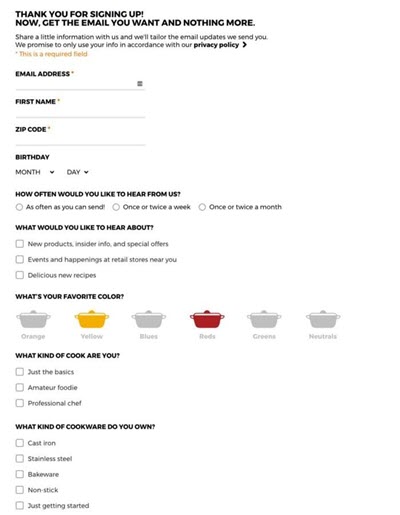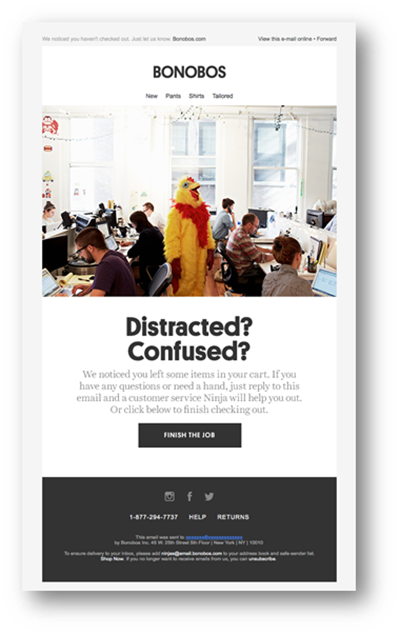7 email stats and what they mean for your business
I've been working in the industry for some 17 years now. I fell into it totally by accident; it was a time when people referred to email as spam. It was soul-destroying. But despite the hard times email has established itself as an essential part of any marketers box of tricks. Right now I want to talk about stats, especially stats that pump email up and act as a kind of cheerleader for the channel. But before we dive in, let's get something straight. I'm entirely aware that around 70% of all statistics are made up, and a lot of them made up on the spot, but that in itself got the cogs in mind clunking away. Sure some stats aren't worth the paper they're written on, they're misleading and can often usher you down a dead end. But, interpreted the right way they can inspire and motivate businesses to try new things, experiment and improve on their offerings to their customers. So allow me to sift through a selection of email stats, dissect them and tell you what they really mean to you, your business and your email program.
In 2019 293.6 billion emails were sent and received each day.
Long live email! As if you didn't know emails are popular. Just have a look at your inbox, how many did you receive today? They'll be a whole mix of them; some expected, welcomed and required. Some are super useful and forwarded to friends and family. Others don't fit into any of the categories above and sadly never see the light of day. So what does this stat really tell us, well often you're a small fish in a big pond, and unless you stand out from the others in the inbox because your customers are expecting you, you're going to have to swim harder to get noticed.
Using the data you collect on your recipients is critical. It'll help make you more relevant which in turn will make selling so much easier, boosting your conversion rate and ROI. If your content is relevant and timely, you'll create more of a connection with your audience. So go that extra mile to turn them into fans, provide them with valuable content and try not to suffocate them by sending too much. Pay attention to what they're telling you and if they're the shy and silent types ask them. But if you're asking, be willing to use what they tell you and change content or cadence accordingly.
Love them or hate them, preference centers can be an ever-present outlet for subscribers to tell us what they'd like to hear. The better you configure yours, the easier it should be for you to churn out that relevant content. That means don't go offering an option to receive one email daily if you don't have the bandwidth or the content, you'll just be letting everyone down.

This example from Le Creuset gets to the bottom of what emails their customers want to receive. But also takes the opportunity to find out a little bit more about the individual too (which hopefully they'll use to target more effectively). My only comment here is that they ask how often recipients would like to hear from them. In my experience, this is difficult to manage because it means you will need to decide which 2 or 3 emails a recipient gets. What if you have 4 or 5 great useful and engaging emails that month? Should you break your own rules and send more than they asked for or stick to what they’ve asked for and flip a coin? It's a tough call, but ultimately I would suggest using more than just a preference center to determine whether or not an email they haven't necessarily requested to received is useful to them or not. If you can harness a customers movement around your site and of course good old links clicked you can build up a pretty good picture of what will keep them engaged. But it’s probably best to stay clear of a specific number and focus on being more relevant.
For every £1 you spend on emails marketing, you can expect an average return of £42
This has got to be every email marketers favorite stat, right?! The magic number £42.24 (to be exact) is the average ROI of email marketing according to the DMA, 2019. That's unrivalled, and this is why email is the backbone of marketing strategies, no matter the industry or sector you operate in. Because it can be so effective, it needs to be taken seriously. Whether you're new to the channel or you've been using email for a while, you need to maximize the potential offered by it. Which means your strategy needs to be geared for success. With the right approach, you'll see your list grow, and the quality significantly improve, customer engagement will also go through the roof, ultimately offering endless opportunities.
What this stat isn't saying is that you'll instantly be making £42 for every £1 you put in from the get-go; It means there is potential. So batch & blast, spray and pray tactics are probably not going to give you the gains you're looking for. Speaking of gains, the better fuel you put in, the better the outcome, so take care of your databases. List hygiene should be one of your top priorities. If the ESP you use doesn't take list hygiene seriously, you should seriously think of moving to a platform that does. Put crap in, get crap out and that £42 will be nowhere near your reach. OK, I think I've made my point here on to the next.
The average open rate for a welcome email is 50%.
First off let's not get upset if your welcome email open rate is nowhere near this figure.
1. If they're nowhere near, let's optimize,
2. this is an average, and averages can be misleading,
3. who cares about open rate?!
OK, I might be a little harsh when I say who cares; but it's not the metric that your email program should be dependent on. Surely ROI and conversion rates win there, but if opens are your bag, a welcome emails is where it's at.
What this statistic is telling us is your welcome emails are essential. Most of the time you'll find that your welcome email outperforms your "standard" or business as usual (BAU) emails. Mostly because this is often the first meaningful interaction with your brand, this individual will have. So make it count. Also, pay attention to whether or not they've just subscribed or have made a purchase; your messaging will want to be different depending on the reason for the sign-up.
Whether or not you build a series of emails or just send the one will be up to you, but the points you'll want to make sure you're hitting are:
- Saying thank you! Maybe it's because I'm English, and I mind my P's & Q's too much, but it's just good manners to say thanks.
- Next up introduce yourself; there are no second chances at making a first impression. What’s your heritage, what sets you apart and what does your brand stand for, in case they don't already know.
- Then get to know them, ask them some questions, but don't be creepy and ask too many questions, no one likes that guy. Remember you can always get the non-essential stuff later.
- Lastly, it's elevator pitch time, give them a reason to buy, renew or stay connected. Why are you better than the next brand? What are your unique selling points (USPs)?
All in all, welcome emails can solidify more engagement throughout the customer lifecycle, so you have to nail this step because then you start a beautiful and lasting relationship. No pressure.

The average time spent reading an email is 13.4 seconds.
Well, this varies massively depending on who you listen to. Over the years I've seen this figure swing from 11 seconds up to 18. Although I'm pretty sure COVID is turning this stat on its head as recipients will more than likely have more time on their hands meaning they'll probably read more of your content. But generally speaking, you won't hold a recipients attention for very long, and in a lot of cases do you really want them lingering on your email? I mean sure you'll have spent some time on it to make it pretty, but the conversion isn't going to happen right there in your email. You want them clicking through to your site or a landing page (don't neglect these by the way landing pages can be a potent tool).
Optimize your campaigns to get your point across quickly, so work out what you're trying to say and say it! Get to the end, and show the recipient what you'd like them to do next.

This Nike email isn’t perfect, but it’s direct. Not much copy at all, the imagery does most of the heavy lifting here, and it’s evident what the next step for the recipient is.
Another point to add is above the fold is your friend. A hero image or a big fat button can get the job done, but don't overcrowd this space. You may not have all the time in the world, but people will scroll through your email if you give them a reason to.
33% of email recipients open emails because of the subject line
Arguably your email subject line is the most crucial sentence of the entire email. And I'm going to give you a nugget of essential information to nailing your subject lines. Test them!
Yeah, you thought I was giving you a silver bullet there, didn't you? Sorry there are no real secrets to subject lines, but some things to consider are:
- Relate it to the rest of your content. No one likes to be hoodwinked.
- Stir up a little bit of emotion, or FOMO. People love being a part of something and hate missing out. Use that to your advantage.
- Use emojis now and then. Emojis can help you stand out from the rest of the uninspiring subject lines in your inbox. But again, don’t overuse them.
- Show your personality. Your language and tone of voice will connect with your readers, make that flow right from the subject line to your email footer. You might also want to vary your vocab using words that only you use and not your competitors.
- Personalize. But that doesn't mean with just the recipients first name. Use other things you know about them to capture their attention, birthday, browsing history even their size could help you stand out.
Even with these five points, you'll still want to test as much as you can. Try it out and see, you've got nothing to lose.
In 2018, 56.6% of email marketers said that they're using animated GIFs at least sometimes in their marketing emails.
Hmm, OK… So this stat doesn't tell us anything at all. It's a little dated, and it's pretty vague on several fronts. But it does give me an excuse to talk about GIFs.
I love GIFs; if a picture speaks a thousand words, then a GIF is off the charts in the word count. They're fun, and make your brand fun while adding an element of delight and they cover the awkward and often messy task of getting a video to work in email. Usually, this bit of movement is enough to surprise and delight a reader, piquing their interest, to get that click-through we're looking for.

This is my absolute favorite GIF in an email. It's super cheeky, teetering on the line of offensive. Still, it illustrates the offer beautifully Larsson and Jennings were giving on singles day, and it also reflects the playful tone of their brand. The text that accompanies the GIF was also spectacular "11.11 is all about gifting yourself or a loved one, and this weekend we're gifting you. Choose two watches, and we will gift you the second one for free" It's simple, but it's effective.
A word of warning, don't overdo it, you run the risk of becoming a one-trick pony, your GIFs may lose their impetus, so save them for when you want to make an impact.
Also, be wary of email clients that don't play GIFs they could poop your party. Outlook 2007, 2010 and 2013 won't show the animation so be sure to know what the first cell of your GIF is and let your audience know that if they click to see the web version they won't forget it! To be sure use a tool that'll help you understand what your email will look like in multiple inboxes like Litmus or Email on Acid.
Over and above the fun aspect, a GIF can help you get the point across quickly; you don’t have all the time in the world (13.4 seconds remember).
The overall average open rate for basket abandonment emails is 40.14%
Lastly, I thought I'd end on something that I have a love-hate relationship with. I love abandon cart emails, simply because they've always been an excellent way for a client who's never used them before to pick up some low hanging fruit. But as with most strategies, some brands get lazy with them and don't optimize them, and that's where my hate seeps in.
Yes sometimes people leave things behind in their carts, but it doesn't always mean they're looking for a deal. A lot of the time you're training your customers to wait for the offer when they would have bought at full price anyway. What we need to do with abandon carts is to understand why the cart was abandoned in the first place.
Segmentation is the key to unearthing what is going on and allow you to customize a message based on where they are in the customer lifecycle. The reason a first-time buyer abandoning a cart will more than likely be different from a loyal customer. And those reasons can vary from industry to industry. But by effectively using segmentation, you can send more relevant messages and avoid giving up margin when you didn't have to.
Always consider the timing of the send. In most cases sending within the first hour will mean the lead doesn't go cold; but consider the price of the product and its scarcity, sometimes a customer will just need more time to convert. In which case the email it just a reminder that it's still there when they need it.

Something else to bear in mind is whether or not the individual was simply saving this item for a payday or a special occasion. In which case the cart hasn't been abandoned at all; they fully intend to come back for it later. Take this Bonobos example here; I love it because it's just asking questions of the would-be customer; “do you need a hand? If so our team of customer service ninjas will help out.“ One way to help a customer that only wants to save things for later is by introducing a wishlist. They allow the user the ability to store the product and come back to it when they want to purchase; and you to give them regular updates if stock levels fall or if the price changes; two things I'm sure a prospective buyer would love to hear about.
I'd love to say I'm right 100% of the time and if you follow everything I’ve said here you'll never have an email issue. But the truth of the matter is best practice is only best practice if it works for you. And the only way to find out if it works is to test. So I have a confession; I have one more stat. "59% of companies A/B test their emails." That's pretty high, but it should be higher. We should be testing continuously; how else are we expected to grow our email programs? So don't be afraid to try new things out, but develop a testing culture in your business to ensure what you’re doing is working and making the most significant impact. Good luck!

 How to resolve AdBlock issue?
How to resolve AdBlock issue? 
